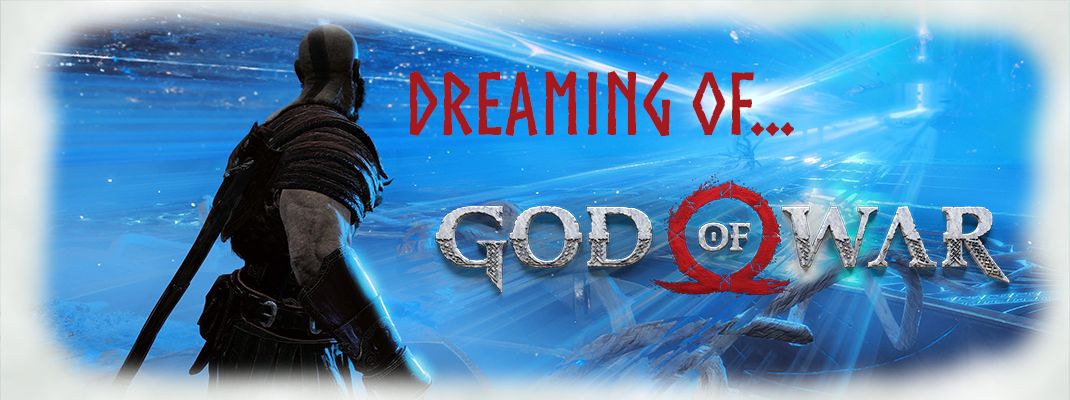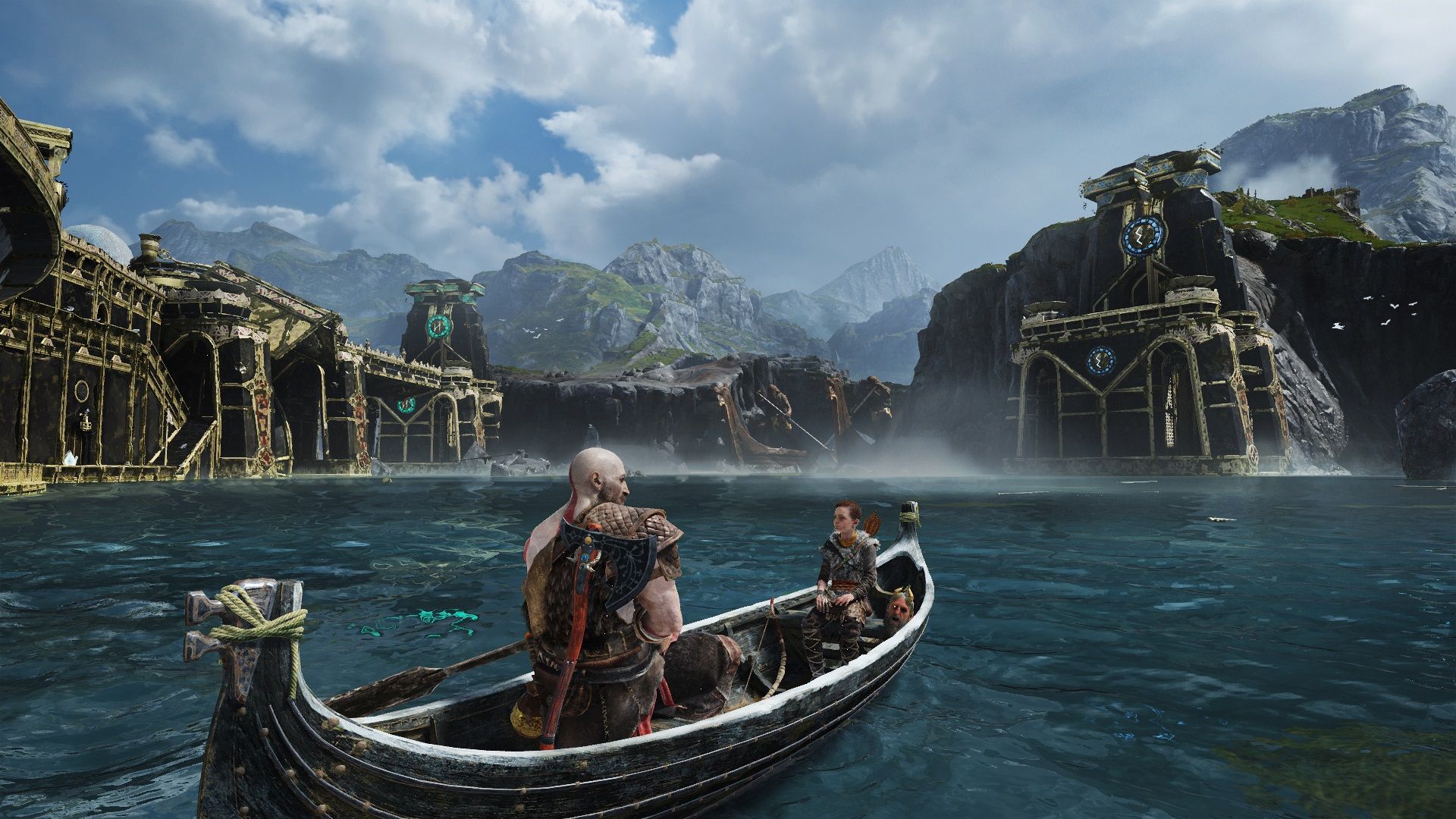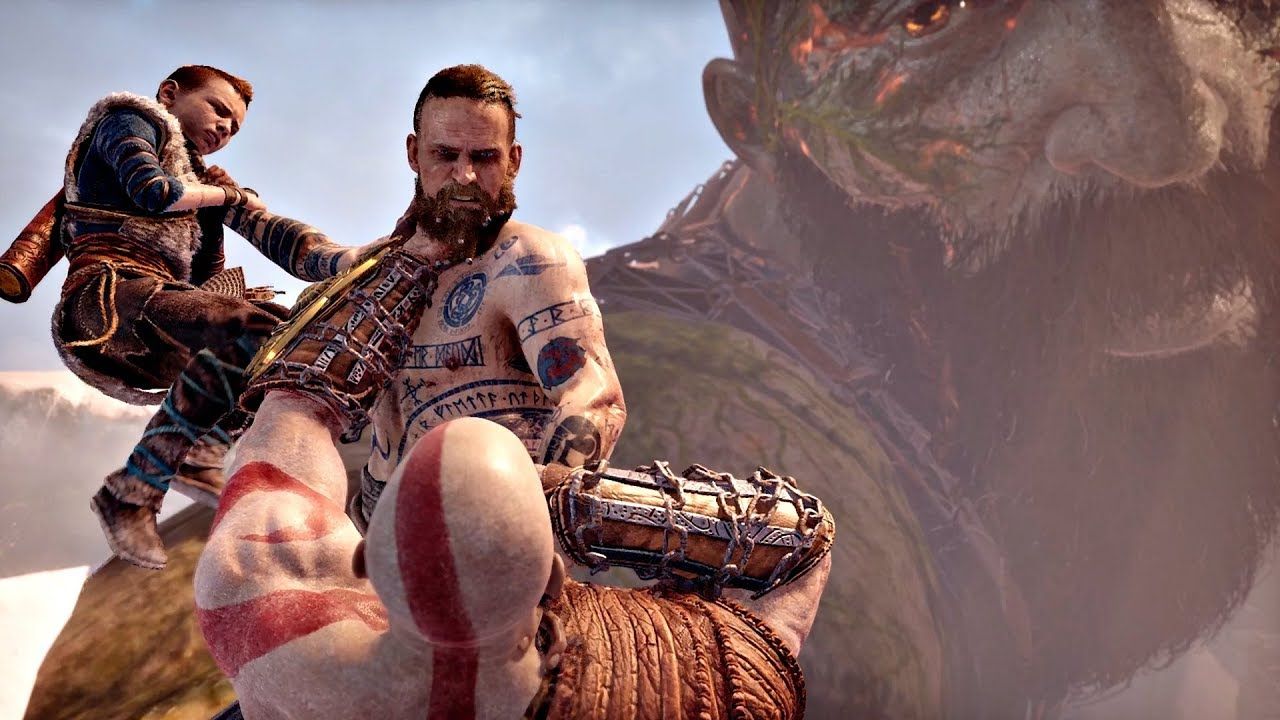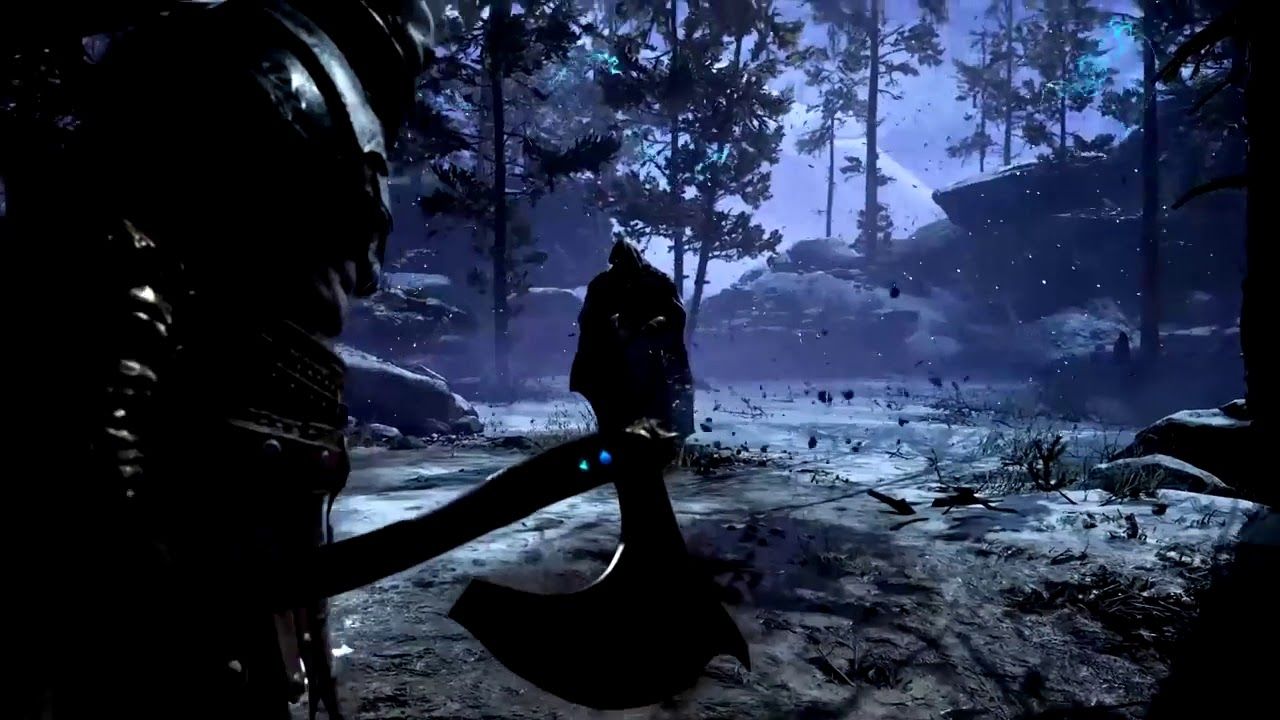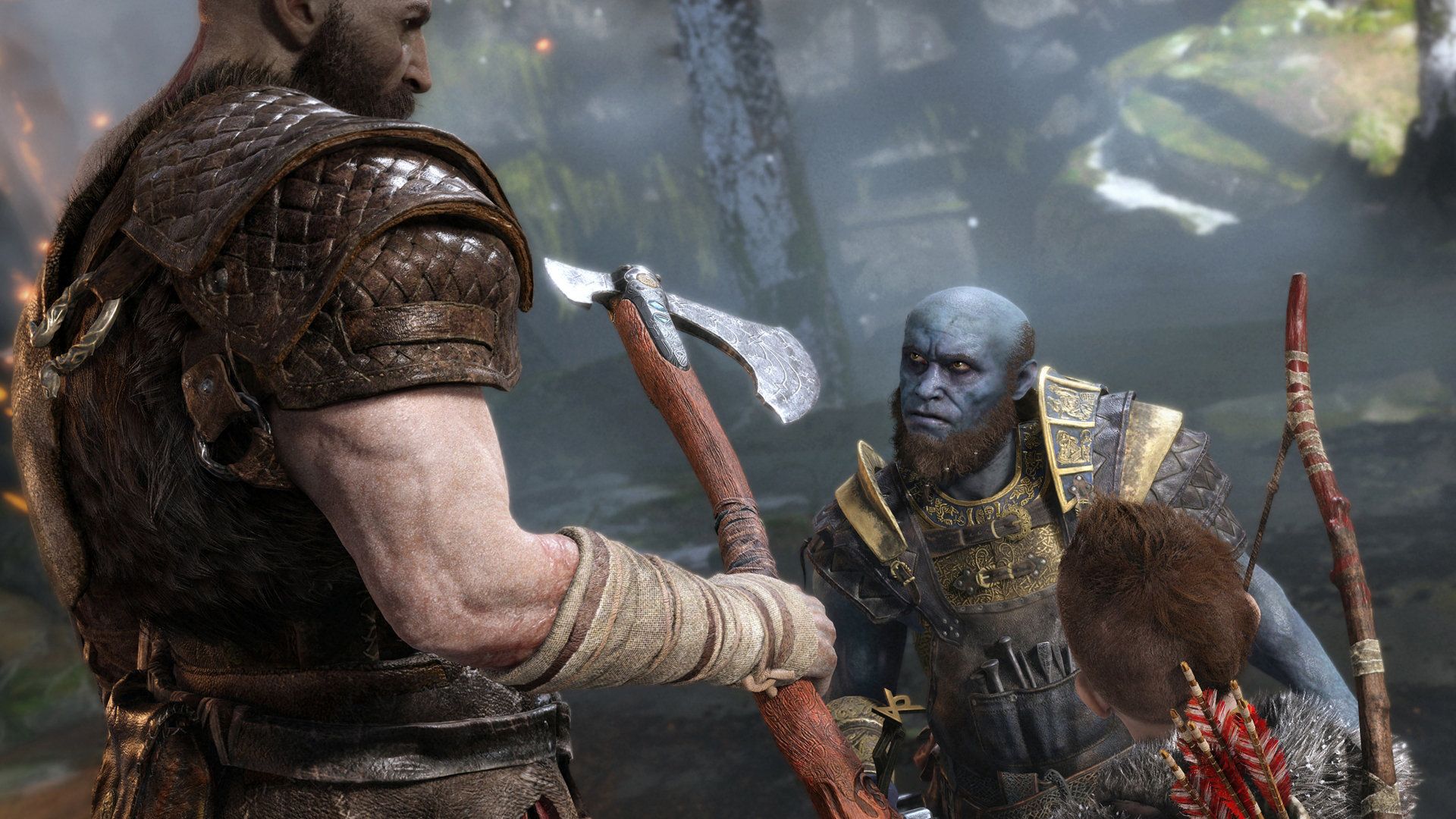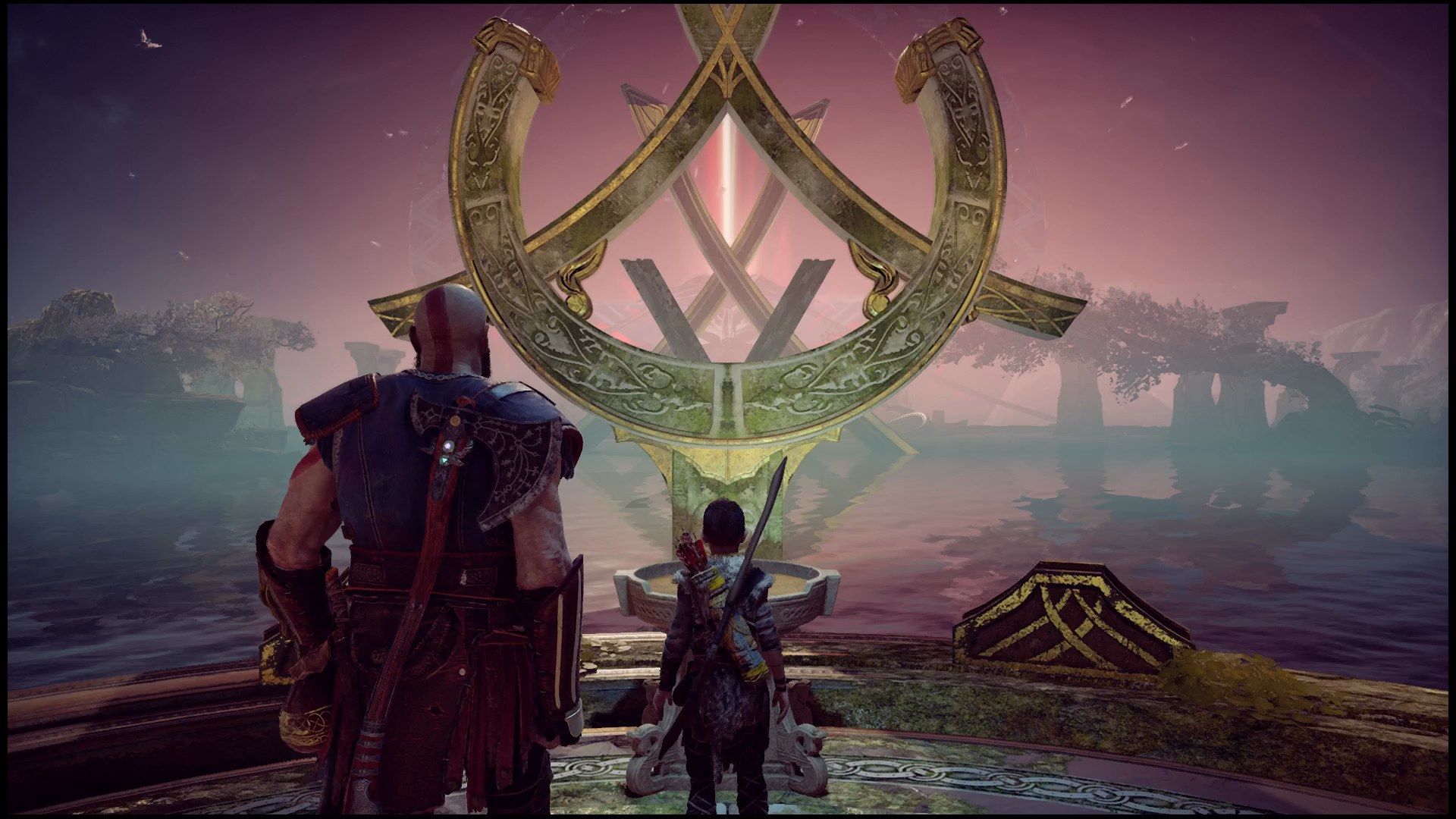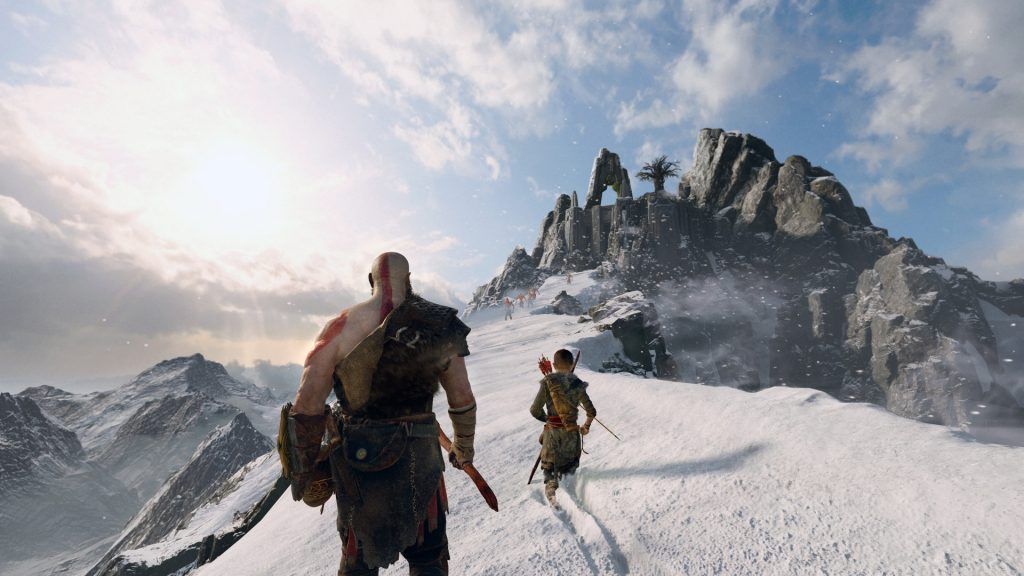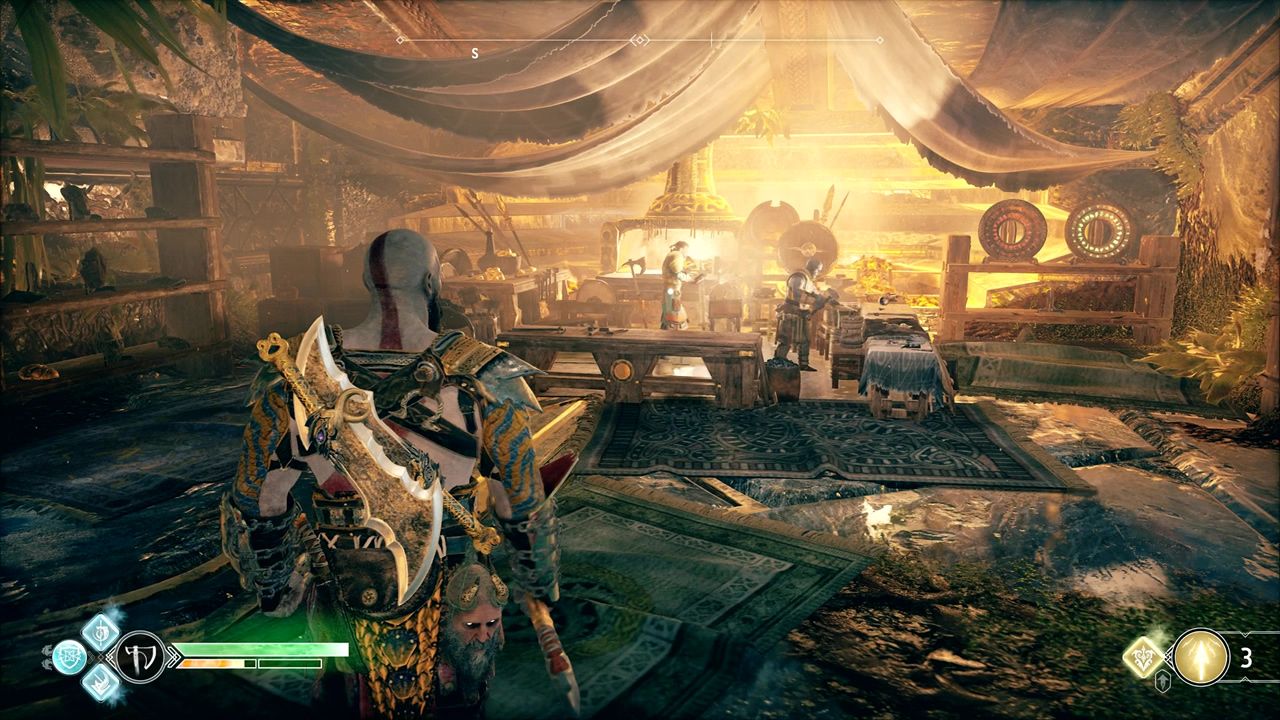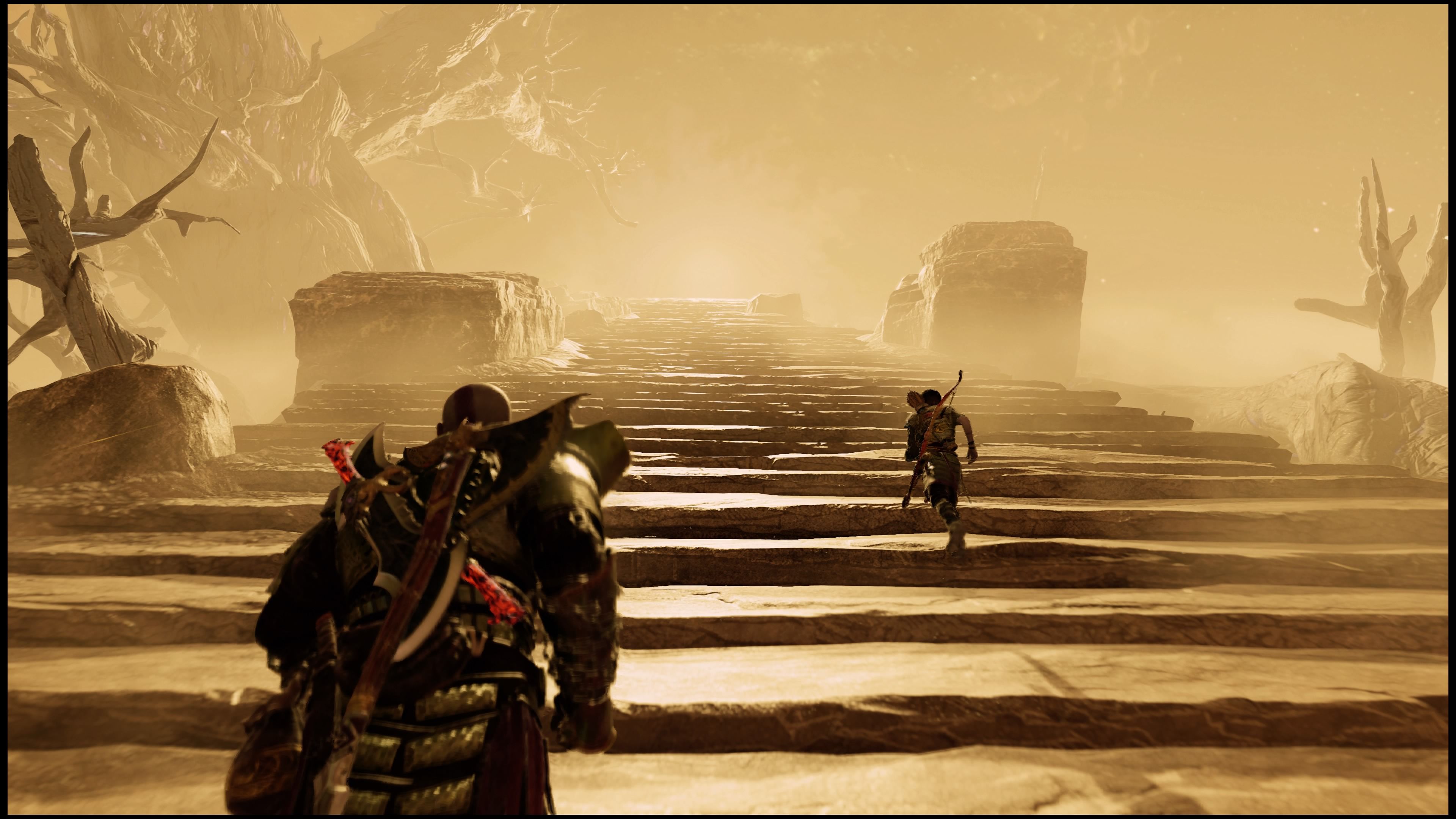This is Dreaming of… a monthly feature that digs deep into unannounced (or barely announced) games, and with some research and a bit of guesswork, dreams up what that game might be like when it’s actually released.
Now that the new God of War is out in the wild and fans across the world have had the chance to enjoy (and possibly even play through) it, Hardcore Gamer felt the time was right to ask the big question: what’s next? Well, we’re here to let our wildest dreams run free. With some background research and a whole heck of a lot of guesswork, we’re going to go ahead and envision the next entry in this ever-improving series. Just don’t expect the game to come out any time soon – probably not even in this console generation.
Warning: the rest of this article contains major plot spoilers, so if you haven’t played through God of War yet, bookmark this page and come back to it later. And if you’re having trouble tracking down and solving all those pesky Nornir chests and doors, we’ve got you covered.
Kratos and Atreus
After killing Baldur and finally getting the opportunity to take the ashes of Atreus’ mother to the highest peak in Jötunheim, the godly father and son duo experience some major revelations. Atreus’ mother Faye was a Giant originally from Jötunheim, making Atreus part Greek God (certainly not an Aesir God like Thor or a Vanir God like Freya) and part Giant. Faye (or the other Giants) had the ability to see into the future and knew that she would die and Kratos and Atreus would go on this journey with her ashes and end up exactly where they did at the end of the game.
All of this information was etched across stone walls leading to the highest peak in the realm, but the revelations didn’t stop there. In a final panel that only Kratos sees, it appears that Kratos (or perhaps another man – he didn’t seem to have Kratos’ red tattoos) will die in Atreus’ arms in the future. Atreus is seen screaming, possibly with some sort of energy or force flowing from his mouth. Minutes later, we find out that Atreus is actually Loki, the trickster god who in Norse mythology is responsible for Baldur’s death and the initiation of Ragnarok, the essential end of the Norse pantheon and rebirth of the world.T
Though God of War borrows from Norse mythology liberally, it can be assumed that the death of Baldur at the end of this game, largely with Atreus’ involvement, will signal Ragnarok in later games. What that means for Kratos and Atreus is uncertain, but there appears to be a definite possibility that Kratos will eventually die and Atreus will take over as the series protagonist. This relationship between father and son is key throughout the new God of War and losing Kratos could prove to be devastating to Atreus. Their parental dynamic was mirrored by Baldur and Freya’s dysfunctional relationship and may again be mirrored in future games, possibly positioning Odin and Thor as a future mirror to Kratos and Atreus.
The Aesir and Vanir
The new God of War curiously kept the number of Norse gods to a minimum, mostly introducing minor gods and figures that aren’t widely known in the pop-culture consciousness. Yes, Baldur and Freya (who is possibly an amalgamation of the characters Freya and Frigg from Norse mythology) are decently major, and Jörmungandr the World Serpent is supposed to kill Thor during Ragnarok, but even they aren’t well known to the general public. You know which Norse gods are? Thor, Odin and Loki.
The secret ending of God of War, which can be seen by returning to Kratos’ cabin after beating the game, shows one-year pass, with Thor arriving at their doorstep with raging lightning in his wake. After the credits roll, Atreus says he saw this in a dream, so while this may or may not be canon, it’s clear the future of the series looks to integrate the more major gods – heck, in that scene alone, both Thor and Loki are accounted for, meaning the only huge figure in Norse mythology we haven’t seen in the flesh is Odin himself.
Using Odin and Thor’s relationship as another mirror of Kratos and Atreus’ relationship could work wonders in a new game. In this most recent God of War, it wasn’t revealed until the later parts of the game that Freya was Baldur’s mother and this parent/child dynamic is used to reflect Kratos and Atreus’s relationship – wherein the protagonists managed to work though their struggles, these antagonists did not. The pain (or lack thereof) that Freya caused Baldur resulted in a destructive dynamic that ultimately sent both characters over the edge and Baldur to his grave. In the next game, the way Odin and Thor interact with one another could very well tell an entirely different story. A son looking to get out of his father’s shadow, or a father attempting to withhold his own power from his son, could very well play into the next game’s narrative. These themes could also be used with Kratos and Atreus. Especially with a teenage or even adult Atreus in the future, their father/son dynamic has a lot of places it can go.
Our bet is that the next God of War will be all about clashing with Thor. We believe this not only because he shows up in that secret ending, but because he feels intentionally absent from this most recent game. It’s likely Odin will show up too, but this has the vibe of a new trilogy, one that needs a solid beginning (which we’ve already gotten,) middle and end. It’s a natural progression, then, that it started with the lesser brother that is Baldur, will continue with the golden-boy Thor and climax with Odin in the throes of Ragnarok, much like God of War III ended with a battle between Kratos and Zeus. Freya is sure to be involved as well and is likely to be a thorn in Kratos and Atreus’ side throughout the next game or two. Other lesser gods and creatures from Norse mythology are bound to be involved as well, and even if there isn’t as sprawling of a Pantheon as in Greek mythology here, there’s still a lot of lore to pull from. Mix that with Kratos possibly dying at the end of the next game at the hands of Thor and you’ll have a stunning conclusion with Atreus going after Thor’s father Odin in the final game. Of course, this is all conjecture, but it’s plausible guesswork at that.
Location, Location, Location
Yes, Kratos and Loki have already traveled to a lot of realms, but there’s still a lot of ground to cover in upcoming games. It’s almost a sure thing that Midgard will be used again, as it’s essentially the “Earth” realm in Norse mythology, though don’t expect Santa Monica to just retread the old ground they already did in the Lake of Nine surrounding the Tyr’s Temple. More areas across Midgard are sure to be uncovered and traveled to, and like this last God of War, it will probably house the majority of the next game’s content.
Helheim is also likely to make a return, not only because the God of War series is obsessed with sending Kratos to the underworld, but because Hel is a character in-an-of-herself, just like Hades was for Greek mythology. Sure, she’s supposed to be Loki’s daughter, but so is Jörmungandr, and something tells us Santa Monica aren’t about to retcon this conception into their narrative. The massive bird off in the distance of Hel isn’t interacted with at all in God of War, and though we aren’t sure exactly which character this might relate to in Norse mythology, it may have something to do with one of the three cocks that crow singling the end of the world with Ragnarok. With so many Norse stories intertwining with Hel, it’s a surefire thing that it will return as a location in the future.
Alfheim was the first non-Midgard realm Kratos and Atreus travel to, and while they spent quite a bit of time there, there’s reason to believe they’ll make a return in the future. After restoring the light of Alfheim, Kratos and Atreus successfully drive the dark elves from the realm (for the most part), but one of the dark elves leaves with a warning, saying that Kratos and Atreus have made a mistake and picked the wrong side. It’s possible that the duo will find in the future that this realm should have been controlled by the dark elves after all. Even if they don’t, if the player returns to Alfheim in the newest God of War after the credits roll, Mimir will mention that the war between the light and dark elves is constant, and it’s likely we’ll see this continue in the future.
Muspelheim and Niflheim are unique locations in God of War, as they are totally optional and can’t be accessed unless the player finds four cyphers for each realm. Once they’ve done that, they can be accessed through the Bifrost. Musphelheim is essentially an arena world with six tiers of difficulty and many different challenges. It’s a good excuse for extra and specific combat encounters and could act in a similar function in the future. Niflheim is largely randomly generated, and honestly kind of a pain to deal with due to its odd mechanics. We don’t think we’ll see Niflheim and its obnoxious mist in the same form in the future, but there are multiple Norse tales that take place in the realm, so it could be visited in a greater capacity in future God of War games.
Jötunheim, the land of the giants, is briefly visited at the end of God of War. It’s desolate and empty, devoid of life or any sort of challenges. It exists in the game solely as a narrative beat, and while it’s very interesting in that regard, it doesn’t seem like a place where much more would go down. Of course, there’s a well of source material to draw from in regards to the Jötunheim of Norse mythology, so it could return in a more active fashion.
There are three of the nine realms left totally unexplored in God of War: Asgard, Vanaheim and Svartalfheim. Asgard and Vanaheim are sure to be major locations in future God of War games, as they are the realms of the Aesir and Vanir (respectively) and Kratos and Atreus not journeying there is highly unlikely. Asgard could end up being the Mount Olympus of this era of God of War and be a major location for a final game where Kratos and/or Atreus face down many of the major Aesir left standing – specifically Odin. Vanaheim seems like a likely location for Kratos and Atreus to spend a lot of time in during the next game and could see the duo siding with the Vanir in a war against the Aesir, even if Kratos doesn’t trust any gods regardless. Svartalfheim, on the other hand, is home to the dwarves and perhaps even the dark elves and is likely to be visited as well. In fact, all three realms show up as locations within the Bifrost but aren’t accessible due to Odin’s interference. You can bet on these places showing up in the future.
Yggdrasil, the ash tree the connects all nine realms, is in God of War, but just barely. It’s involved in the Bifrost, is used during fast-travel and was used by Tyr to hide access to Jötunheim, but being such a major pillar of Norse Mythology, expect its return. There are also other locations and even mythologies referenced in God of War, including a desert land that sure sounds like Egypt. During a scene that discusses the Gods of War in different areas of the world, something that looks like the eye of Horus is shown, though Horus was not the God of War in Egyptian Mythology. This could mean even more mythologies will be involved in the God of War series. We think it’s more likely other mythologies will be explored after Norse mythology is wrapped up much like Greek mythology was after the original games, but only time will tell.
Gameplay is King
Though story and setting will be paramount to the future of God of War, gameplay will remain its primary factor of success. The new God of War dramatically changed the way the series plays, placing the camera just behind Kratos’ shoulder, giving control of the camera directly to the player. It also switched out his Blades of Chaos for the Leviathan Axe – at least for the first two-thirds of the game. It opened up the structure of the series to allow more optional content into the game than main story material and gave the player RPG elements to leverage this freedom brilliantly. All of these things and more will continue into the future God of War games, but more ingredients will inevitably be added to the mix.
The behind the shoulder camera perspective will almost certainly stay for the indefinite future of God of War. It allows for personal, aggressive combat and its inclusion has few detractors since the game’s release. It can cause a bit of confusion, as the camera does have a tendency to cut enemies behind Kratos off the screen, even though they’re about to attack him. There are, of course, the danger indicators that work well, but this minor issue is sure to be reduced even further in the next God of War.
Adding in more weapons with each new entry is a God of War tradition, and the next game in the series is likely to have more than just the blades and axe. Once the Blades of Chaos are obtained in the newest God of War, the two weapons balance each other beautifully. It’s unlikely, however, that Santa Monica will rely solely on those two weapons in the next God of War, even if they do work exceptionally well as a fire/ice, close/midrange duo. Weapons like the Bow of Apollo from God of War III added range to combat, and the Blade of Olympus starting in God of War II gave Kratos a close-up weapon of destruction to unleash on his foes. Though we fully expect Santa Monica to get even more mileage out of the blades and axe, we anticipate even more variety in future releases.
The openness of God of War has been noted by critics and fans alike, but we think this is just the beginning. God of War is unlikely to go fully open-world, and we like it that way. This new game offered a great balance of story gameplay and optional content, and the structure that the game employs could very well be replicated for a sequel. As the game progresses, the Lake of Nine’s water levels lower more and more, opening up even more areas for Kratos and Atreus to explore. This lends to a Metroid-vania like structure, where players regularly return to previously discovered locations after major story beats and acquiring new weapons/abilities that let them go places and open things they previously couldn’t. The sequel is likely to retain these traits but will possibly branch away from the Lake of the Nine – unless they undergo some major changes to make the rediscovery of its various areas interesting for a fourth or fifth time around.
The Next God of War
The next God of War will likely pick up exactly where the last one left off: with Thor at Kratos and Atreus’ doorstep. This will remind players of Baldur’s appearance at the beginning of God of War, but with a much more explosive entrance. Instead of a contemplative and deliberately slow introduction that we got with Frigg’s cremation, Thor will opt to immediately try to kill Kratos and abduct Atreus. Baldur, Thor’s half-brother, was taken from him by Kratos, and his revenge aims to be final. Kratos instructs Atreus to return to the house, and though he first argues, Atreus ultimately complies.
Players will be re-introduced to combat mechanics during this opening battle, first with Kratos summoning the Leviathan Axe to his hand during the first phase of the fight. After taking a beating from the God of Thunder, Atreus delivers the Blades of Chaos to Kratos and he brandishes them once again, turning the tide of the fight. Eventually, Thor destroys their house, though Atreus manages to save Mimir from inside just in time. Recognizing he’s losing the fight, Thor grabs hold of Atreus and flees towards the Bifrost – it appears that he wants to take Atreus to Asgard for unknown reasons. Kratos makes chase and the conflict continues to escalate across the Wildwoods, eventually bringing the fight to the Lake of Nine.
The Lake, like the rest of Midgard at this point, is completely frozen due to the weather shift that signaled the beginning of Ragnarok. Kratos catches up and he and Thor clash across the frozen lake, but Kratos quickly loses the upper hand and Atreus is knocked unconscious. Just as Thor is about to deliver a final blow to Kratos, Jörmungandr appears and aims to kill Thor. These two now fight endlessly, and with Jörmungandr’s massive size, their battle fades off into the distance. Removed from the precious little protection the Wildwoods gave, Kratos and Atreus are quickly surrounded by an army of the dead. The problem that began during the last game has escalated, and though the spirits of the Valkyrie have been freed, their role in guiding righteous souls to Valhalla, which resides within Asgard, is no longer tenable, and the souls are flooding Midgard.
Mimir suggests they make for the Bifrost immediately and travel to another realm to escape, so Kratos picks up Atreus and makes for the center of the lake. Upon reaching the central chamber, Mimir notes that somebody had recently used it to travel to or from Vanaheim, which had been locked during the last game. With few other options, and an army of the dead knocking at their door, they travel to Vanaheim. Upon their arrival, they find a much different world than the frozen wasteland that was Midgard.
Just as it was shown in Freya’s magical window, Vanaheim is beautiful, lush with magical flora and fauna. However, both Atreus and Mimir sense that not all is well. Leaving the Bifrost chamber, the trio are quickly ambushed by a group of Vanir. Being generally peaceful gods, Mimir is confused at the action, but is able to convince the mysterious group to lay down their weapons and escort the trio to the realm’s major palace.
A natural and wonderous land, the Vanir’s homes are one with a large root of Yggdrasil. Kratos, Atreus and Mimir meet with Frey, Freya’s twin brother. It appears that she managed to somehow return to Vanaheim, which she had previously been restricted by Odin to enter ever again. She came to strike a deal with Frey, but negotiations fell apart as the Vanir no longer trust Freya. Frey and the rest of the Vanir recognize that Ragnarok is just beginning, and knowing the future, they are doing everything in their power to stay out of the coming conflict. They don’t want Kratos bringing danger to their doorstep, but they see the threats that Freya, Odin and Thor pose, and decide to use the trio to do their dirty work by proxy.
Frey bestows his magical sword to Atreus, recognizing his lineage and showing his respect for the deceased Faye. From this point on, Atreus becomes the second playable character. The player can freely swap between controlling Kratos and Atreus with the push of the button. When one is being controlled, the other is taken over by an advanced A.I. – as before, Kratos can command Atreus to fire arrows, but now Atreus can command Kratos to attack enemies while he’s being controlled as well. Atreus’ sword and bow act as close-range and long-range weapons and greatly differ from Kratos’ blades and axe. Just as Kratos’ blades and axe deal fire and ice damage, Atreus’ arrows still come in the electric variety, but the light imbuement is now exclusive to his sword. He controls much like Kratos does but is nimble and light. He can jump on command, aiming his bow in mid-air if desired, but he has far less defense and health than Kratos. The two complement each other well, and their weapons create a great foursome dynamic that make dispatching certain enemies at specific times more strategic and entertaining.
From this point on, Kratos and Atreus regularly return to Vanaheim as a sort of central hub, much like the Lake of Nine was used in the most recent game. Optional tasks from the Vanir will be given to the player, many of which take place in Vanaheim, though some will take the player to other realms. Vanaheim is gorgeous but varied, with many environments, including lush forests, desolate deserts, and cavernous mountains.
The dwarves Brok and Sindri return, though Brok is currently alone in Vanaheim. It appears that Sindri has returned to Svartalfheim, the home of both the dwarves and the dark elves. Access to the world, however, has been severed, and even Brok cannot return with his unique powers. He refuses to show it, but he’s desperately concerned about his brother and does everything in his power to convince Kratos and Atreus to find a way there and make sure Sindri is alright. Like in the last game, from this point on, Brok will somehow show up in various locations, fully set up with his blacksmith shop.
Armor, weapon and rune upgrades all still exist in this new God of War and function similarly to how they did in the previous game. Hacksilver is still the currency and upgrades require other more specific materials you gain throughout your travels. New to this game is a recipe system, where after beating certain enemies, specifically bosses with armor, Kratos and Atreus gain recipes for new armor and runes that they can take to Brok and make this new equipment for themselves if they have sufficient materials. Many of these pieces can only be made by beating optional enemies, further incentivizing optional quests.
Because Atreus is now a playable character, he has just as many upgrading opportunities as Kratos, including full armor sets, the ability to equip runes and a full skill tree for each of his weapons, with one tree specifically tied to his acrobatic abilities, which can increase his jump height, duration and slowdown time when aiming mid-air. All runes can be used by either character, but armor and weapon upgrades are unique to each. The Blades of Chaos and Leviathan Axe can now be upgraded using two types of resources, one unique to each weapon, and one shared by both, meaning players have to decide which weapon they want to upgrade over the other when they obtain this material. The same goes for Atreus’ bow and sword, thus customizing each character is more in the player’s hands than ever before.
As per Brok’s wishes, Kratos, Atreus and Mimir begin to look for a way to access Svartalfheim, and the only lead they have to go on is that the war between the light and dark elves has reignited in Alfheim, meaning the dark elves are somehow getting from Svartalfheim to Alfheim. Frey, being the guardian of Alfheim, accompanies the three in hopes of ending the war peacefully. They take the Bifrost and find that things are worse than they could have imagined.
The light elves, once seemingly peaceful, have become excessively violent and Freya seems to be the one leading them. She has once again become the queen of the Valkyrie and has taken to bloodlust in the wake of Baldur’s death. She’s gone as far as siding with Thor and Odin once more, which explains her ability to leave Midgard. The dark elves, on the other hand, also have a powerful being leading their charge: the great wolf Fenrir. Fenrir is intelligent but bloodthirsty, and desires nothing more than to kill Odin. Even with this commonality, he wants Kratos and Atreus dead as well, meaning both the light and dark elves are gunning to kill the player. The Light of Alfheim constantly shifts from light to dark, as the balance of the battle is unstable and neither side has the upper hand.
Eventually, after defeating one of the leaders of the dark elves, Atreus obtains dark arrows, which are highly effective against light elves and other creatures of light that have been turned by the Aesir. Freya and Fenrir both confront the trio at the same time, resulting in a major clash between all three parties, creating a dynamic and hectic boss battle. Frey uses his Vanir magic to try and bind Freya while the player escapes Alfheim. Just as they near the Bifrost, Thor intervenes and begins a fight with the player. This fight is short lived, as Fenrir appears and begins to viciously attack Thor. Knowing that Fenrir is capable of killing Odin, Thor flees with Fenrir in pursuit. The trio take the Bifrost back to Vanaheim knowing the Aesir cannot follow them there, even if Freya can.
This initiates a brief respite in the story, allowing the player to partake in even more optional content in Vanaheim if they wish. Brok approaches the trio, asking about Sindri, though they have no news to give him. Frustrated, Brok leaves to find his own way to Svartalfheim. If the player chooses to continue the story line, they’ll discover that Brok has learned of a way to reach Svartalfheim, but it involves breaching Yggdrasil itself. Kratos refuses, fearing this could destabilize the Nine Realms and claiming this matter none of his business, but Atreus refuses to leave Sindri in danger. Mimir does not know which side to take, and a small rift between Kratos and Atreus begins to form, though their love is still strong.
Frey returns from Alfheim, severely injured, unable to stand upright on his own. He barely survived the fight with his sister and is convinced she will be unable to cease her desire for vengeance on Kratos and Atreus. Frey knows the light elves and Alfheim are now in Freya’s control and decides that the only way the Vanir could ever defeat the Aesir is to side with the dark elves and Fenrir. Thus, he implores Kratos and Atreus to take Brok’s advice and enter Yggdrasil in order to reach Svartalfheim.
The foursome, including Brok, are granted access to the roots of Yggdrasil by Frey, and begin a long and difficult journey. The inside of the tree is made up of splendid crystals, and all of the elements, including fire, ice, electricity, light and dark exist within the tree, and many new enemies appear. Variations of enemies that the player had seen before, like the draugr, trolls, elves and more, are imbued with crystal here, and are more powerful than ever. These crystals become their weak points for Kratos and Atreus to focus on. It’s revealed that if any creature, god or mortal, remains within Yggdrasil for too long, they will become corrupted with its crystal powers and can never leave. Thus the foursome proceed with more speed than ever before, eventually reaching Svartalfheim in one piece.
Expecting a war torn, desolate and dark climate, Svartalfheim is surprisingly beautiful and somewhat peaceful. The dwarves and dark elves coexist in peace and Sindri has been revealed to be just fine. He has been crafting weapons and armor for the elves alongside the other dwarves. He apologizes to Brok for leaving without word, but because Brok had been banished from the realm, he went without him, and hadn’t left the realm since because he was so focused on his blacksmithing. The dwarves attempt to imprison and execute Brok, resulting in a massive fight between the dwarves, Kratos and Atreus. Eventually, they fight the king of the dwarves, and upon defeating him, Brok is granted the right to return to Svartalfheim.
Brok and Sindri remain with the dwarves, but still show up randomly at small blacksmith locations to aide the player. They also reveal their brother Eitri, a bit of a know-it-all that can improve the player’s equipment in ways his brothers cannot. Kratos, Atreus and Mimir make their way to Fenrir’s cave, far within the cavernous mountains. After fighting though many foes, including hundreds of dark elves, they reach Fenrir. He’s been injured by Thor but is still a deadly opponent, and a boss fight ensues. Just before dealing a death blow to Fenrir, Kratos implores Atreus to hold his fire. Atreus, filled with rage and adrenaline, very nearly disobeys his father’s advice, but seeing the fear in Kratos’ eyes, he holds back. They then strike a deal with Fenrir, and the Vanir, dark elves, Fenrir, dwarves, and the trio are now on the same side against the Aesir, light elves, Freya and the army of the dead. A war is brewing, and it’s clear Ragnarok is approaching.
The player now reaches a new point in which more side quest options are available, both in Vanaheim and Svartalfheim. If the player decides to continue with the story, they’ll initiate a major war between light and dark, of which they are on the “dark” side, though it appears that their party is in the right to try and stop the “light” side from brining ruin to all Nine Realms. Along with a massive army behind them, the player returns to Alfheim for an all-out war.
Bloodshed is everywhere, with each race tearing one another apart. Kratos, Atreus and Mimir set off to face Freya and Thor directly. A major fight ensues, with Frey and Fenrir assisting in the battle that spans the entire realm and even manages to make its way into Yggdrasil. The tree itself begins to attack all within it, Frey and Freya break off into their own fight, Fenrir deals with the tree and Kratos, Atreus, Mimir and Thor end up back in the frozen Midgard. Their battle is intense and fraught with electricity: thunderbolts rain from the sky and the player loses the upper hand.
Ultimately, the voice of Odin pulses in the atmosphere, advising Thor to end his attempt to abduct Atreus and instead kill him. Thor manages to smash Frey’s magic sword into pieces. Just as Thor is to deal a deathblow to Atreus, Kratos throws himself in harm’s way and Thor’s hammer Mjölnir becomes deeply lodged within Kratos’ chest. Filled with anger, Atreus enters a state of Spartan Rage for the first time, frightening Thor. He attempts to flee, but Atreus is too fast, furiously firing off dark arrows in Thor’s direction. Thor attempts to call Mjölnir, but it will not come. Atreus catches up with Thor and pins his hands and feet down with dark arrows. About to loosen an arrow into Thor’s skull, Mimir speaks from nearby, still hanging on Kratos’ waist, and implores Atreus to weigh his actions before killing Thor. He does so anyway.
Atreus returns to Kratos, who lies on the lake bleeding out with Mjölnir in his chest, pinning him to the ice. He says that it is too late, and that nothing can save him now. He is off to find Faye, as well is his slain first wife and child in the afterworld. Atreus refuses to let his father go and manages to pull Mjölnir out of Kratos with ease. Kratos tells Atreus that he is proud and that he loves him – he proceeds to breath his last breath. Atreus holds Kratos in his arms and screams out in rage and grief and swears to avenge his father’s death by killing Odin.
Atreus collects his father’s body and belongings, as well as his broken sword, placing Mimir on his own hip, and takes him back to their destroyed home in the Wildwoods, which is now overrun with the undead. They fear Mjölnir, which Atreus swings with ferocity. He uses the same pyre that his mother was cremated on to turn Kratos to ash. He takes these ashes with him and travels once more to Jötunheim. After spreading these ashes at the peak, more of the mural is unveiled to Atreus. He now sees the panel that shows his father’s death, but he also sees more. He sees himself travel to Asgard and confront Odin, though in the end, the mural shows Odin kill him. Mimir implores Atreus to change his course, but he does not listen.
The dwarf brothers appear and offer their condolences, though they are impressed and confused by Mjölnir’s choice to give his allegiance to Atreus. They offer to take Kratos’ Blades of Chaos and Leviathan Axe and make them into bracers that Atreus can wear, as well as fashion the broken sword into new light arrows. He accepts, and the powers within Kratos’ old weapons are now given to Atreus, including the option to use ice and fire attacks. All of Kratos’ XP is also transferred to Atreus, allowing players to unlock some of the more expensive abilities they likely couldn’t before. Still grief stricken, not knowing what to do, Atreus decides not to go to Asgard or to return to Alfheim to end the battle, but instead he travels to Hel to speak with his father.
Upon reaching Hel, Atreus finds a horrific scene of lost souls of humans, light and dark elves, dwarves, killed gods and more still fighting, creating an intense and difficult atmosphere. Eventually, Atreus and Mimir make their way to the massive bird that resides in hell. Atreus takes it on in a major battle that spans Hel, and eventually kills it. Soon after, the goddess Hel reveals herself and is enraged at Atreus’ actions. The two fight, and Atreus murders her as well. He demands she tell him where his father’s spirit is with her last breaths, and she reveals that even with the Valkyrie gone, Kratos must have been powerful enough to make it to Valhalla on his own. Atreus now knows his path forward.
He returns to Alfheim to find only death and corpses strewn about the land. He makes for Vanaheim and discovers the Aesir have managed to breach its magical barriers after Freya killed Frey. The fighting was brutal, though some of the Vanir survived, telling the player that the Aesir returned to Asgard. Atreus makes for Yggdrasil and finds that Fenrir is still fighting the tree. After a major battle, Atreus begins to destroy Yggdrasil from the inside with Mjölnir, tearing apart the fabric that ties the Nine Realms together and proceeds to Asgard, despite constant warnings from Mimir. They end up at the entrance of Asgard, Atreus filled with rage and a single drive: to kill the Aesir and find his father’s spirit in Valhalla (which resides within Asgard). He tells Mimir to call him Loki, and the two enter Asgard.
Tying Up Loose Ends
This new God of War would be titled God of War: Yggdrasil and would come out sometime after the PlayStation 5 hits the market. It sets up a third and final game called God of War: Ragnarok, which will parallel God of War III in many ways, including Loki’s lust for vengeance and journey to murder every god in their own land. Though it took Sony Santa Monica five years to make the most recent God of War, this one will take slightly less time, at 3-4 years. Despite being on a new system, the game will run on the same engine that God of War did, which helps with development significantly. Cory Barlog will not be at the helm, as he’ll be off making a new IP for Sony, but he will help oversee its story and overall production as a producer.
The themes of the game are light and darkness, blurring the lines between what is right and wrong, good and evil. The game is still very much about the relationship between father and son, but now Atreus is a teenager and the difficulties in his relationship between himself and Kratos stems from his narrowmindedness and inability to see the world from a wider perspective. Just before Kratos dies, he and Atreus have a major fight, and Atreus is distraught that they did not resolve their conflict, ashamed at himself for how it ended. This all further fuels his rage in God of War: Ragnarok.
The future of God of War is bright, and while Santa Monica may eventually delve into something like Egyptian mythology, their focus is squarely on Norse mythology for this trilogy. Santa Monica has a lot of hype to live up to with this future installment, and even if it doesn’t even remotely resemble what we’ve laid out here, they are sure to make this sequel bigger and better than ever before.
This has been “Dreaming of…” our monthly feature that dreams up what might be in the world of gaming. If you liked this, check out Dreaming of Resident Evil 8, Dreaming of the Next Legend of Zelda, or even more of our ongoing features. For all of your news, reviews and more, keep an eye on Hardcore Gamer.

